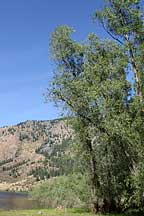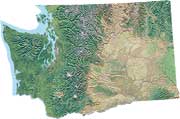 Sinlahekin wildlife area is a long valley that was set aside in the late 1930's, mainly as a wintering ground for mule deer that migrate from the Pasayten Wilderness and surrounding highlands. The wildlife area is in the middle of a so-called "sportsman's paradise" for hunters and fishermen, located in eastern Washington west of Tonasket and north of Conconully. It's also a great place for wildlife watchers including birders, butterfliers, and various other "ers" who have got to get outside to experience the wonder and humor of reality.
Sinlahekin wildlife area is a long valley that was set aside in the late 1930's, mainly as a wintering ground for mule deer that migrate from the Pasayten Wilderness and surrounding highlands. The wildlife area is in the middle of a so-called "sportsman's paradise" for hunters and fishermen, located in eastern Washington west of Tonasket and north of Conconully. It's also a great place for wildlife watchers including birders, butterfliers, and various other "ers" who have got to get outside to experience the wonder and humor of reality.
The Sinlahekin valley is in a dry climate yet has lakes and a river running through it, and is oriented north-south, so the variation of dry sunny exposures and moist shady areas create microhabitats that support a myriad diversity of wildlife. The area is also off the beaten track and relatively quiet, and with its web of food sources it's a fine place for wildlife to take refuge.
Mule deer that inhabit the Sinlahekin like the upland areas where the bitterbrush grow for dusk-to-dawn browse, and the ponderosa pine stands in shaded draws for good cover to snooze through the heat of the day. Down in the valley, groves of black cottonwood, quaking aspen, and willow grow where there's easy water, where white-tailed deer browse. Various amphibians inhabit the lowlands including western toad and Pacific treefrog, and reptiles such as common valley garter snake and terrestrial garter snake, and some rattlesnakes. Other wildlife to be seen in the Sinlahekin include bighorn sheep, black bear, wild turkey, pheasant, quail, beaver, porcupine, skunk, badger, Columbian ground squirrel, and pine squirrel.
Fish Lake and Blue Lake offer fishing for sizable rainbow trout, which can be spotted on warm evenings lazily sipping bugs on the surface. Blue Lake also holds large brown trout. With the narrow valley, long shady periods extend the "prime time" to be out fishing.
Butterflies begin emerging in early spring with California tortoiseshell, Compton's and Milbert's tortoiseshells, mourning cloaks, and satyr anglewing, green, and hoary commas breaking their winter dormancy. In April, spring azure, Sheridan's green hairstreak and western green hairstreak, and spring white butterflies emerge and into summer, various parnassians, swallowtails, sulphurs, fritillaries, coppers, whites and skippers take wing, along with the freshly emerging brood of tortoiseshells and commas. The area is host to a lot of butterfly species, all dependent on a lot of host plants and habitat conditions.
The Sinlahekin generally offers great birding and is a stopover for migratory water birds. In April, trumpeter swans and tundra swans stop at the area lakes, where common loons call to you. In July, wood duck, cinnamon teal, blue-winged teal and green-winged teal, redhead, ring-necked duck, Barrow's goldeneye, bufflehead, hooded and common merganser, red-necked grebes, common loons, and great blue herons are around to be seen and heard.
While set in a beautiful place, the campgrounds around the lakes can be abused by a few visitors, and if space and time will permit, it will help improve the quality of the area by taking out an extra bag of garbage or broken glass. Also, the south end of Fish Lake may be fouled by wafting pies of beef cattle that range freely through the valley in summer, and perhaps is best avoided.
For more information about this recreation area visit excellent related sites listed at the left of the page.

